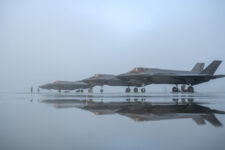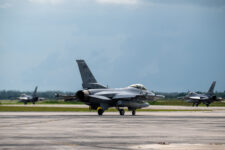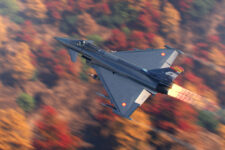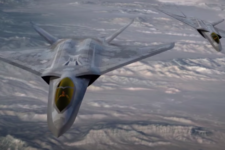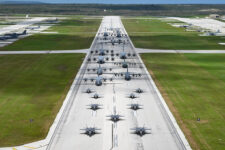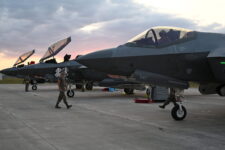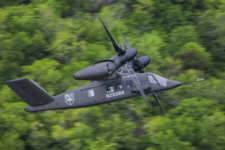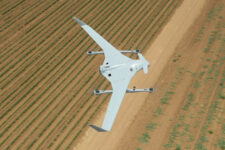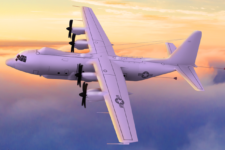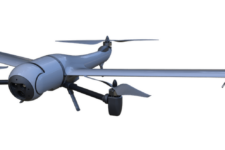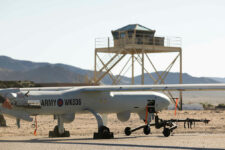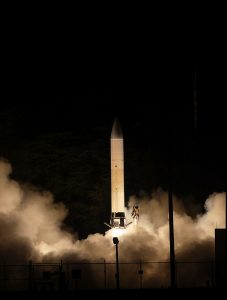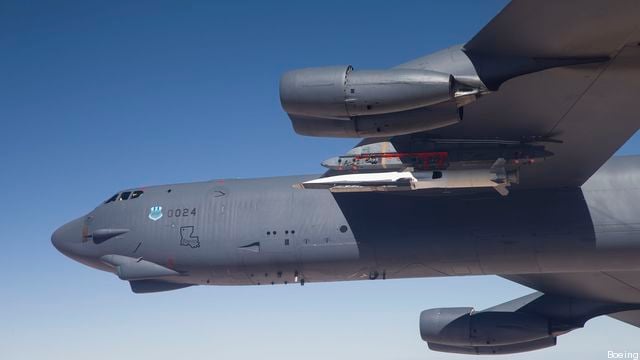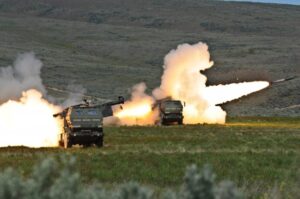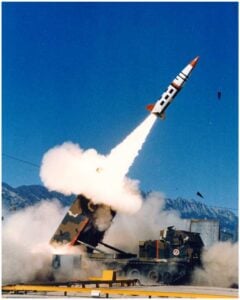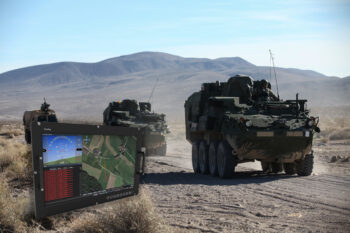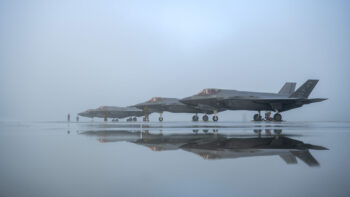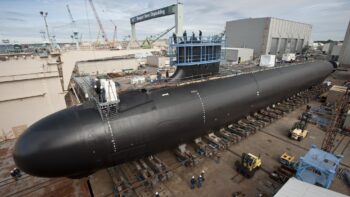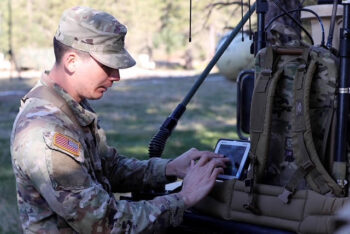
The US Army’s Advanced Hypersonic Weapon. The AHW warhead will now form the core of the Air Force’s hypersonic weapons as well.
ARMY S&T CONFERENCE: The Army is quietly playing a crucial role in the Pentagon’s quest for hypersonic weapons. The service’s modestly named Alternate Re-Entry System is in fact a maneuverable warhead — what’s called a “glide body” — that could end up on Mach 5-plus missiles fired from Air Force bombers and Navy vessels, as well as Army launchers on land, sort of a new non-nuclear triad.
It’s all part of Pentagon R&D chief Mike Griffin‘s all-out push to catch up with Russia and China. Both powers are testing hypersonic weapons that could zip through traditional air and missile defenses.
“We need to do something dramatic,” said Griffin’s No. 2, Mary Miller (who joined his staff after years with the Army). “We have the services all in on working hypersonics. We have land-, sea- and air-based prototyping that will be done,” she told the National Defense Industrial Association conference here.
Now, the Army hasn’t awarded any $500 million to $900 million contracts like those recently announced by the Air Force. But its Alternate Re-Entry System — funded at $197 million in 2018 — is in fact the primary warhead being used by the Air Force.
“We each have pieces of programs,” Air Force Secretary Heather Wilson told a Washington Post forum last month. “The Army’s warhead had worked much better than the Air Force’s….So we’re going to take the Army warhead, put it on an Air Force booster, launch it off of a B-52, while the Army is developing on the ground and the Navy wants to put it on the deck of a ship.”
“We came up with a memorandum of understanding. We’ve got all of our people working together,” Wilson said. “This kind of collaboration will accelerate testing and deployment by several years…so we’re talking 2021, 2020 possibly, to test.”
Miller, similarly, said the goal was fielding weapons in the “early 2020s.”
Why Army Hypersonics?
“We’re doing this jointly with the other services; most of the testing right now is done tri-service,” the Army’s chief scientist, Thomas Russell, told me here. “We have some test capabilities that the other services use for hypersonics, (and) a lot of this is right now in our foundational work, just doing propulsion and other areas.”
But while the underlying technology would be similar for all the services, “we would have different operational requirements in a ground-based system than we would actually have from a sea or an air-launched system,” Russell told the NDIA conference. The Army, he said, is now “working through what ground-based requirements are (and) how to develop those technologies for a ground-based weapons system.”
Why is the ground force working on such a long-range flying weapon? For the Army, hypersonics is simply the logical extension of current precision-guided artillery missiles like GMLRS and ATACMS. The service’s No. 1 modernization priority is so-called Long-Range Precision Fires (LRPF), which covers everything from upgrading self-propelled howitzers to precision rockets to long-range missiles. “We’re interested in very deep fires,” Russell said.
While Russell wasn’t explicit today, it’s clear from other sources that the Army is looking seriously at longer ranges than the current 500 kilometer (312.5 mile) maximum set by the INF Treaty, which China never signed and which Russia is allegedly violating. The Army’s aware that such “strategic deep fires” would mean land-based artillery would strike targets now reserved for airstrikes and cruise missiles — but they see that as synergy, not redundancy.
Defensively, a land-based launcher can hide in forests, cities, or caves in a way an airbase or warship cannot, making it harder for the enemy to destroy all the US missiles before they launch. Offensively, if enemy air and missile defenses can block the Air Force or Navy strikes, maybe the Army’s will get through. In fact, being able to threaten the enemy from multiple directions at once — from the land, air, sea, space, and cyberspace — is the central concept of the emerging concept of future combat, championed by the Army, called multi-domain operations.
But before the US military can execute these futuristic concepts, it needs to get the tech to work.
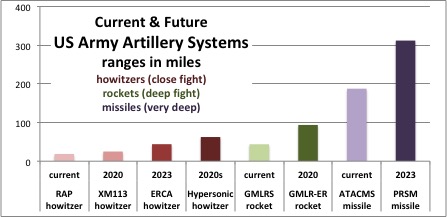
RAP: Rocket Assisted Projectile. ERCA: Extended Range Cannon Artillery. GMLRS: Guided Multiple-Launch Rocket System. ATACMS: Army Tactical Missile System. PRSM: Precision Strike Missile. SOURCE: US Army.
Hypersonic Evolution
As its name implies, the Army’s Alternate Re-Entry System evolved from what was the Pentagon’s backup plan. The original idea, Prompt Global Strike, called for simply putting conventional warheads instead of the usual nuclear payload on Air Force or Navy ballistic missiles. But an adversary would have no way of telling whether the incoming warhead was a nuke or not until it hit, potentially scaring them into launching their own nuclear weapons.
A “boost-glide” weapon, by contrast, uses an ICBM-style booster to reach hypersonic speeds but then detaches and flies through the atmosphere. Unlike a true hypersonic cruise missile, which has engines that thrust continuously throughout its flight, a boost-glide weapon uses the immense momentum, or “boost,” of the initial launch to “glide” — albeit at over 3,800 mph.
Hypersonic boost-glide has three advantages:
- The radar and heat signature are easily distinguished from those of any ICBM, reducing the chance the target will panic and launch nukes.
- The “glider” warhead travels through the air, or at least bounces like a skipping stone across the upper atmosphere. That makes it a very hard target for current ballistic missile defense systems designed to hit warheads in empty space.
- The warhead’s also “gliding” at more than five times the speed of sound and can maneuver like an aircraft, rather than following a predictable ballistic course like an ICBM or Scud. That makes it a very tough target for current cruise missile defenses designed to hit missiles moving at a mere Mach 2.
The same physics that make a hypersonic warhead hard to shoot down, however, also make it hard to build. Moving at Mach 5-plus in the atmosphere creates tremendous friction, requiring special materials just to resist melting from the heat. (ICBM warheads also heat up immensely, but only during final reentry, since they spend most of their time in airless space). Actually changing course at Mach 5-plus in atmosphere creates even more stresses, potentially causing the warhead to break up.
It was the Army that made key advances in maneuvering a hypersonic warhead in atmosphere. Back in 2011, the service conducted a successful flight test of a boost-glide system it then called the Advanced Hypersonic Weapon. “Once it’s gliding, it’s able to fly cross-range, left or right in its flight path,” Army Space & Missile Defense Command’s hypersonics chief, Bob Strider, told an internal publication.
As the authoritative Congressional Research Service reports, the Army’s AHW had been originally seen as a backup “Alternative Payload Delivery Vehicle” for the Conventional Prompt Global Strike Program (CPGS), with the Air Force’s longer-ranged Falcon HTV-2 as the primary system, but HTV-2 struggled in its tests, pushing the Army system to the forefront.
AHW failed its high-stakes second test in 2014, blowing up the booster with no data collected. But the Army succeeded in October 2017 with a downscaled version — sized for launch from a Navy submarine.
At this point the Pentagon planned to transfer the technology from the Army the Navy. The Army’s own efforts seemed to go into limbo. As recently as August 15, an official Army website published a story saying “whether the Advanced Hypersonic Weapon or any land-based hypersonic vehicle will be fielded is still an open question. (The Army) does not plan further tests of the Advanced Hypersonic Weapon….until Army leadership makes policy and budgeting decisions. The ball is in the court of the cross-functional team dedicated to long-range precision fires, headed by Brig. Gen. Stephen J. Maranian.” (We interviewed Maranian here).
Now, it looks like Army leadership has made those decisions. While officials as senior as Chief of Staff Mark Milley have previously talked about Army hypersonics in general terms, today’s statements by both the Army’s Russell and OSD’s Miller were unequivocal: The Army wants a ground-launched hypersonic weapon.
Why Hypersonics Are No. 1
Why has Undersecretary Griffin made hypersonics his absolute top priority for all the services? “Because right now China and Russia have been expending a lot of their resources to get hypersonics,” his No. 2, Miller, told us this morning. “They are projected to field capability in the early 2020s….They can hold us at risk, they can keep us off their borders, and they can certainly threaten our carrier groups.”
Hypersonics are fundamentally an offensive weapon, though the US is researching defenses against hypersonics as well, which Miller said is actually an even harder problem. The US wants hypersonics in its offensive arsenal because potential adversaries have built up advanced multi-layered air and missile defenses — sometimes called Anti-Access/Area Denial (A2/AD) — that could block US airpower and cruise missile strikes.
“We’re (becoming) unable to strike any adversaries at will in some places,” Miller said. In particular, she said, “the Chinese have done a good job of pushing out of their borders and we worry about that.”
Miller’s being brutally honest here. Since the fall of the Soviet Union, the US has gotten used to being the sole superpower, able to strike anywhere on earth at will. Imagine how this feels for Putin or Xi Jinping, and you can understand why they’ve invested heavily in countermeasures.
Regaining the American ability to strike anywhere on earth — as unnerving as that can be to other nations — will require more than really fast missiles, however.
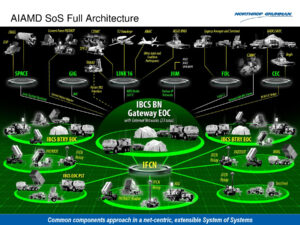
A simplified (yes, really) overview of the Army’s IBCS command-and-control network for air and missile defense.
“We need to make sure we are not just investing in a missile or a launcher but that we have and field a kill chain,” Miller said. That chain runs from detecting the target, to tracking it precisely as it moves, to making the decision to fire, to striking the target, to assessing the damage and deciding whether to fire again. “We will be looking portfolio-wide across the services and agencies to ensure we have the pieces of the kill chain all showing up at about the right timeframe, so when we field to the combatant commands, we give them a holistic capability.”
But the Pentagon can’t afford to buy unique radars, satellites, and command posts exclusively for hypersonic weapons, the way Patriot missile launchers were built to work exclusively with Patriot radars. And they want to pull information from as many sensors as possible. “We typically think of the kill chain as one sensor to one shooter,” Russell said: The goal should be “multi-sensors, multi-shooter, multi-service,” with commanders able to draw on targeting data from across the US military and then launch whatever weapon is best.
That’s a tremendous technological challenge. The Army’s been wrestling for years with integrating its own air and missile defense systems, using a network called ICBS. To coordinate offensive strikes across all the services at hypersonic speeds, Russell said, “those calculations need to be completed in a few milliseconds if you really want to do multi-sensor, multi-shooter across all domains.”
Pentagon awards Lockheed $11.8 billion undefinitized F-35 production contract
The Pentagon aims to finalize the contract for production lot 18 by the spring, though a similar award for lot 19 is not planned to follow until the fiscal 2025 budget is approved, according to the F-35 Joint Program Office.
